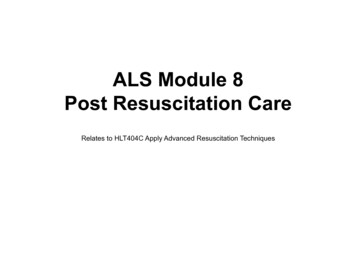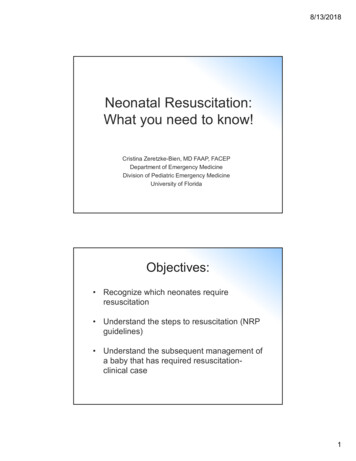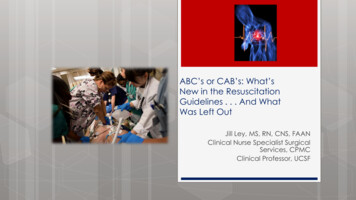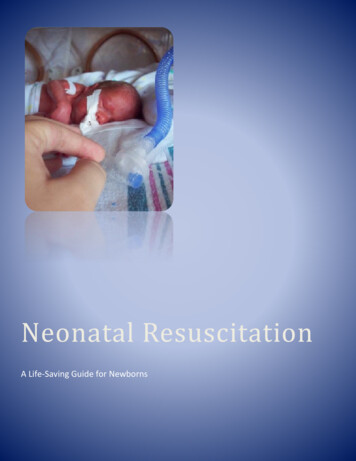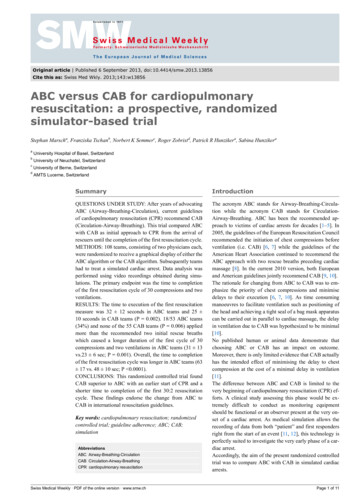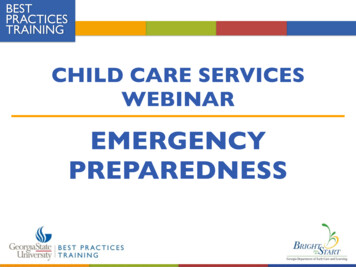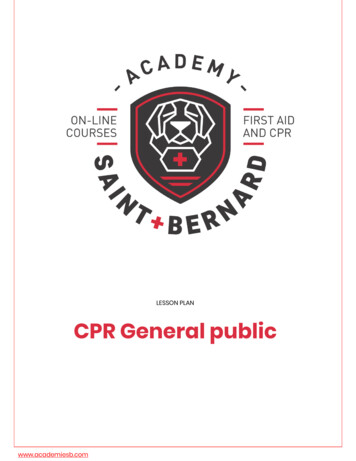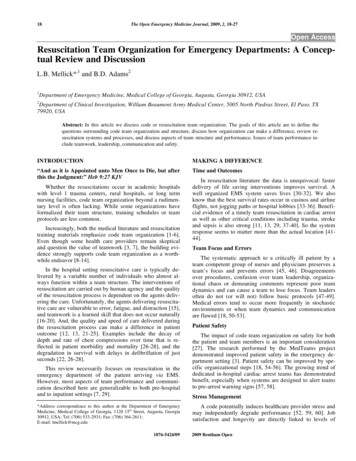
Transcription
18The Open Emergency Medicine Journal, 2009, 2, 18-27Open AccessResuscitation Team Organization for Emergency Departments: A Conceptual Review and DiscussionL.B. Mellick*,1 and B.D. Adams21Department of Emergency Medicine, Medical College of Georgia, Augusta, Georgia 30912, USA2Department of Clinical Investigation, William Beaumont Army Medical Center, 5005 North Piedras Street, El Paso, TX79920, USAAbstract: In this article we discuss code or resuscitation team organization. The goals of this article are to define thequestions surrounding code team organization and structure, discuss how organization can make a difference, review resuscitation systems and processes, and discuss aspects of team structure and performance. Issues of team performance include teamwork, leadership, communication and safety.INTRODUCTIONMAKING A DIFFERENCE“And as it is Appointed unto Men Once to Die, but afterthis the Judgment:” Heb 9:27 KJVTime and OutcomesWhether the resuscitations occur in academic hospitalswith level 1 trauma centers, rural hospitals, or long termnursing facilities, code team organization beyond a rudimentary level is often lacking. While some organizations haveformalized their team structure, training schedules or teamprotocols are less common.Increasingly, both the medical literature and resuscitationtraining materials emphasize code team organization [1-6].Even though some health care providers remain skepticaland question the value of teamwork [3, 7], the building evidence strongly supports code team organization as a worthwhile endeavor [8-14].In the hospital setting resuscitative care is typically delivered by a variable number of individuals who almost always function within a team structure. The interventions ofresuscitation are carried out by human agency and the qualityof the resuscitation process is dependent on the agents delivering the care. Unfortunately, the agents delivering resuscitative care are vulnerable to error, fatigue, and distraction [15],and teamwork is a learned skill that does not occur naturally[16-20]. And, the quality and speed of care delivered duringthe resuscitation process can make a difference in patientoutcome [12, 13, 21-25]. Examples include the decay ofdepth and rate of chest compressions over time that is reflected in patient morbidity and mortality [26-28], and thedegradation in survival with delays in defibrillation of justseconds [22, 26-28].This review necessarily focuses on resuscitation in theemergency department of the patient arriving via EMS.However, most aspects of team performance and communication described here are generalizable to both pre-hospitaland to inpatient settings [7, 29].*Address correspondence to this author at the Department of EmergencyMedicine, Medical College of Georgia, 1120 15th Street, Augusta, Georgia30912, USA; Tel: (706) 533-2931; Fax: (706) 364-2611;E-mail: lmellick@mcg.edu1876-5424/09In resuscitation literature the data is unequivocal: fasterdelivery of life saving interventions improves survival. Awell organized EMS system saves lives [30-32]. We alsoknow that the best survival rates occur in casinos and airlineflights, not jogging paths or hospital lobbies [33-36]. Beneficial evidence of a timely team resuscitation in cardiac arrestas well as other critical conditions including trauma, strokeand sepsis is also strong [11, 13, 29, 37-40]. So the systemresponse seems to matter more than the actual location [4144].Team Focus and ErrorsThe systematic approach to a critically ill patient by ateam competent group of nurses and physicians preserves ateam’s focus and prevents errors [45, 46]. Disagreementsover procedures, confusion over team leadership, organizational chaos or demeaning comments represent poor teamdynamics and can cause a team to lose focus. Team leadersoften do not (or will not) follow basic protocols [47-49].Medical errors tend to occur more frequently in stochasticenvironments or when team dynamics and communicationare flawed [18, 50-53].Patient SafetyThe impact of code team organization on safety for boththe patient and team members is an important consideration[27]. The research performed by the MedTeams projectdemonstrated improved patient safety in the emergency department setting [3]. Patient safety can be improved by specific organizational steps [18, 54-56]. The growing trend ofdedicated in-hospital cardiac arrest teams has demonstratedbenefit, especially when systems are designed to alert teamsto pre-arrest warning signs [57, 58].Stress ManagementA code potentially induces healthcare provider stress andmay independently degrade performance [52, 59, 60]. Jobsatisfaction and longevity are directly linked to levels of2009 Bentham Open
Resuscitation Team Organization for Emergency Departmentswork place stress [61-63]. With the code team, processes andprocedures that are organized, disciplined and controlled aregenerally less stressful to the participants [60, 64-66]. Theresuscitation team leader sets the tone for the team and prevents unnecessary stress levels [49].Family PresenceIn the context of increasing family presence, we havevisitors and observers with highly emotional agendas andstakes. Despite depictions of chaotic resuscitations on television, the public’s perceptions of cardiopulmonary resuscitations remain unrealistic [67, 68]. Family members deserve tosee a highly synchronized and disciplined pit crew at work[69, 70], and we should strive for resuscitations that functionwith no evidence of team dysfunction.RESUSCITATION PROCESSESBurkle and Rice first described the team process perspective [71]. The team perspective of a medical or trauma resuscitation involves at least seven phases. Each phase encompasses temporally important priorities for the resuscitationteam.Anticipation PhaseDuring this phase the data provided to the hospital by theparamedics is received and analyzed. Subsequently, the teamis gathered, leadership is established, duties are delegated,the equipment is prepared and checked and the team members position themselves in readiness for the arrival of thecritically ill patients.Entry PhaseThis involves the exchange of vital signs obtained by theparamedics just prior to their arrival. Additionally, there isthe orderly transfer or exchange of the patient to the emergency department stretcher. The hospital resuscitation teammembers obtain baseline assessments of the patients A-BC’s. The paramedics provide a concise history and new vitalsigns are obtained.The Open Emergency Medicine Journal, 2009, Volume 219maintain the team's attention during this phase is an important responsibility of the team leadership.Family Notification PhaseThis is not a single point in time. In fact, the notificationprocess continues throughout the resuscitation process. Theresuscitation team designates at least one member to be aliaison with the family. Frequent, honest status reports andinformation updates are important to family members andshould be carried out with sensitivity [72-75]. This is accomplished whether or not the family is physically present inthe resuscitation room.Transfer PhaseThis phase does not necessarily occur at the end of a resuscitation. The potential for delays in necessary emergentcare can occur if the transfer process is not managed efficiently. Remembering to arrange for transport late into resuscitation may not be efficient management of the patient'smedical or surgical problem.Critique PhaseEvery resuscitation scenario is different and encountersunique problems. The patient care delivered and the team'sinterdependent performance should be critiqued as soon aspossible after resuscitation. This allows maximal educationalbenefit from the process and prevents repeated inefficiencieswith future patients. To varying degrees all resuscitationteams sustain emotional traumas following resuscitations andthe process can be cumulative [65, 76, 77]. Debriefing ordefusing processes can also occur during the critique phasethat allows team members to begin to manage personal griefreactions. This process has been formalized as the criticalincident stress debrief (CISD) borrowed from the disastermedicine experience [65, 76-78].JOB AIDS FOR CODE TEAMSMaintenance PhaseIndustries requiring high precision commonly utilize “jobaids”. Job aids can be checklists containing specific taskelements for which accuracy and oversight prevention aremandatory. A classic example of a job aid is the preflightchecklist used by airline pilots. The most common exampleof a job aid already used widely in resuscitation settings isthe “ABC” (Airway-Breathing-Circulation) mnemonic forestablishing patient resuscitation priorities. Other potentialresuscitation job aids would be a room preparation checklist(See Fig. 1) or a wallboard (See Fig. 2) describing teammember positions around the bed. Job aids may organizetask priorities, standardize activities, prevent inadvertentoversights, allow faster and more thorough completion oftasks and reduce cognitive load [79-81]. They prevent leadership distractions or task drift, ensure a consistent structureto the resuscitation process and decrease team stress. Jobaids transfer resuscitation processes from deliberate cognitive processes to automatic reflexes [79, 82, 83].During this period of time the major assessment and resuscitative procedures have been accomplished. Continuedstabilization of the patient is performed and intravenous linesand inserted catheters and tubes are stabilized. During thisphase the team's “adrenaline rush” begins to subside as themost critical interventions have been accomplished. This is avulnerable time period for the patient. A conscious effort toThere are other useful job aids besides checklists. Documents such as a contemporaneous trauma resuscitation record can increase the efficiency of documentation. Templateorder forms for critical diagnoses improve compliance withevidence based guidelines and patient outcomes [39, 84, 85].Dry erase boards hung on the resuscitation room wall canassist with documentation of the prehospital history orResuscitation PhaseThe team assesses the patients "A-B-Cs" (performs aprimary survey) and carries out urgently indicated resuscitative interventions. Strong physician and nursing leadershipare important during this phase. There should be one dominant voice and information is continuously provided to theteam leadership. Vital signs are documented at least everyfive minutes and procedures and medication administrationare accomplished. The secondary or anatomical survey isaccomplished and when the patient's condition does not improve the physiologic survey is repeated. Effective communication between the team members and leadership is animportant component of this phase.
20 The Open Emergency Medicine Journal, 2009, Volume 2Mellick and AdamsIDENTIFICATION OF TEAM MEMBER ROLES Documentation Nurse: Room preparation checklist, documentation, medication mixing, procedure trays, stays with patient.Lead Nurse: Team preparation prior to arrival, delegates orders through RN from code team captain, traffic control, LEFT Nurse [Chesttube placement, peritoneal lavage, airway clearance], second to leaveCirculating Nurse: RIGHT nurse [Intravenous line, draws blood, medication administration, NG, Foley placement, urine dip], first toleaveTechnician: Places patient on monitors, performs manual BP, foley placement, EKG, Prep for procedures Appropriate sized ventilation bag on bedOxygen ready: humidified oxygen for pediatric patientsSuction on and readyAppropriate size suction catheters availableAirway equipment checked and at bedside – estimate ETT size for childrenBroselow tape on bed – pediatric patientsRapid sequence intubation tray at bedsideEnd tidal CO2 assessment equipment at bedsidePulse oximeter at bedside and ready Manual and automatic BP cuffs at bedsideCPR backboard – available as neededHeat lamps – available as neededIntravenous lines stripped [2] – one line on Level I warmerCPR stepstool – available as neededACLS drugs – available as neededAppropriate size infusion catheters – available as neededCardiac monitor on and event recording readyDefibrillator on: appropriate size paddles [peds, adult, internal] – external pacer padsCall for blood if needed [Give ETA of patient if available] Otoscope bulb functionalAppropriate size soft restraints at bedside Trauma scissors – available as neededTowels or warmed blankets to cover patient after secondary survey accomplishedHeat lamps – available as needed Bedside hematocrit and glucose monitorsAppropriate size foley catheter – available as neededAppropriate size NG tube – available as neededMayo stand at bedsideAdditonal personnel paged [as needed] Are the appropriate invasive procedure supplies readily available? AIRWAY, S THINK AHEAD Fig. (1). Room preparation checklist.individuals responsible for team role assignments [81]. Posters containing reference information can be strategicallyplaced on resuscitation room walls. Pediatric resuscitationdrugs, the Glasgow Coma Scale, and ACLS algorithms areexamples of information that are often posted. The roles,duties and locations of specific team members can also bedisplayed as a wall chart. Such a chart is especially useful intraining center settings where team members regularly rotate.Another important job aid is the Broselow /Hinkle Pediatric Resuscitation System. The Broselow Tape is becominga standard piece of equipment for most emergency departments. This tape allows the application of preset drug calculations and equipment sizes using an estimate of the child’sweight based on the child’s length. This system quickly andaccurately estimates a child’s weight, calculates drug dosesand guides equipment size selection [79, 86].Well thought out systems for equipment organization anddisplay are also valuable to code team organization. Theroom location for equipment storage can affect resuscitationteam efficiency. Minimize impediment of the floor spacearound the patient (especially near the head) by maximizingthe use of overhead storage, x-ray, and outlets. Display airway equipment in a semi-open format on an airway wallboard placed at the head of the resuscitation bed. Many otherequipment display options are available. Equipment cupboards with glass doors or open equipment carts allow easyvisibility and access of supplies. Ergonomic design of resuscitation equipment from drug storage to defibrillator padswill definitely impact overall team efficiency [20, 87, 88].
Resuscitation Team Organization for Emergency DepartmentsThe Open Emergency Medicine Journal, 2009, Volume 221 Fig. (2). Wallboard with resuscitation team room positions, roles and assigned activities.While medical informatics show great promise in resuscitation team communications, a simple informative trackingboard is valuable for managing multiple critically ill patients[81].a barrier to communication, the benefit of leadership is diminished and patient safety is potentially compromised [98102].TEAM DEVELOPMENT AND STRUCTURE Be present in the resuscitation room prior to the patient’s arrival Assemble the team prior to the patient’s arrival Lead the team in patient care planning prior to arrivalof the patient Lead in the assignment and clarification of teammember roles prior to the patient’s arrival Position yourself in the room at a location typical forteam leaders [at head or foot of bed]* Unitize your local system for team leader identification (colored gown, arm bands etc). Be the individual who directly receives the paramedichistoryClearly defined physician leadership is critical to thesmooth performance of the code team [90]. There must beone and only one physician leader at any specific time whoacts as the “sinus node” pacemaker for the resuscitationprocess? To prevent multi-focal and ineffective team leadership, no other “ectopic” leadership foci can be tolerated. Theoccurrence of a “discordant array of specialists each intenton an individual treatment plan” must be avoided [7, 91-94].Well-defined but integrated nursing leadership is also critically important [95, 96]. Leadership admonition may be necessary and appropriate: “Take orders only from me.” Act the part; decibels, rhythm, behavior and tone ofvoice should reinforce your role Establish identity of the team leader nurse and collaborate in resuscitation planning Enlist help of team leader nurse with team cooperation, crowd control and delegation of ordersLeadership is not always a natural process or event andrequires certain finite actions to delineate the leadership role[4, 16, 20, 55, 96, 97]. Steps or actions that assist in leadership declaration are listed below. Experienced leaders recognize the importance, the interdependence and the value ofeach team member. When the hierarchical structure becomes Make eye contact and address other team members byname Maintain ongoing communication that keeps the teamcontinually informedIn 1999, Risser introduced important team work conceptsto the emergency department setting [18, 50, 51, 83, 89].MedTeams is an adaptation and application of aviation flightcrew resource management (CRM) to hospital emergencydepartments. The underlying premise for MedTeams wasthat most errors result from breakdowns in systems-leveldefenses and that a reduction in medical errors was possiblethrough interdisciplinary teamwork. They identified fivecritical dimensions that were necessary for effective teamwork and identified specific, observable behaviors that werelinked to these dimensions.Methods of Declaring Leadership & MaintenanceMaintain Team Structure and ClimateEstablish Leadership
22 The Open Emergency Medicine Journal, 2009, Volume 2*Business leaders have long known that room position signifies and even dictates leadership roles [103-107].Establishing oneself as the leader is frequently an easierstep than maintaining control of the resuscitation. Loss ofcontrol and confusion over team leadership can significantlyimpact on patient care delivery.Organize TeamTeam organization involves assigning roles, developmentof a treatment plan and preparing for the arrival of the patient. In this setting complexity can breed chaos. Therefore,the code team structure and organization should be natural,clinically relevant, easily reinforced and must augment ratherthan distract team member focus from the resuscitation.Standardization of team member roles and room positions clarifies team member duties. (See Fig. 3) In reality,Fig. (3). Code team personnel positions and role descriptions.Mellick and Adamsteam member roles and room positions cannot be rigidlydefined. Variations in room layout, location of monitors andequipment, number of personnel, available skill mix, patientsize or age and the clinical condition being treated are factorsthat will influence roles and team member locations in theroom [46]. Nevertheless, certain roles are assigned to specific room positions because of the activities performed orthe location of major equipment [e.g. airway physician, cervical spine control, CPR administrator, defibrillator, cardiacmonitors, and blood warmers]. Respiratory therapy, anesthesia or the emergency physician in charge of airway are positioned at the patient’s head. Since physicians traditionallyexamine patients from the patient’s right side, the team captain who often performs the physical assessment will usuallyoccupy that location. During different phases of the resuscitation process and depending on the health condition beingtreated, the physician leadership location may transition.
Resuscitation Team Organization for Emergency DepartmentsThe Open Emergency Medicine Journal, 2009, Volume 223Concurrently, the lead nurse who under ideal circumstancesis in continuous communication with the team captain shouldbe located on the patient’s left and across from the physicianteam leader. The location of other team members is dependent upon which procedures are being performed. The documentation nurse is typically stationed within eye contact andauditory proximity (which prevents having to request information) at a writing station or table. If a supply cart is located immediately behind and a drug cart nearby, the documentation nurse can simultaneously assist with equipmentand medication distribution. A wallboard can effectivelydirect the team members to their room locations as well asprompt concerning the duties of their assigned role (See Fig.2).responsible for establishing a healthy team ambiance. Onoccasion, it is appropriate for a team leader to dismiss aninappropriate team member from the resuscitation suite.Compared to the academic medical center the ruralemergency department will have different resources [48, 98,99]. In smaller emergency departments the team captain isoften responsible for the airway and the performance ofother time and attention consuming procedures. In this setting the need for preplanning and team organization is evengreater and it in no way diminishes the need for code teamorganization. Smaller hospitals can create emergency department response teams to augment personnel resources andallow team management of critically ill patients [12, 23, 90].Team members must insure that the team leader has allpertinent clinical information. At the same time the physician leader of the resuscitation must not hesitate to engageteam members in decision making; asking for direction orsuggestions when necessary.Increasingly, modern hospitals pre-designate specificwards or teams to help perform specific therapeutic andsometimes resuscitation functions. Examples include CPRteam, Trauma Team, Chest pain units [CPU], cardiac careunits (CCU) and more recently Rapid Response Teams [10,37, 108]. Because many resuscitations occur after admissionto the hospital, the team roles of CPU, CCU and RRT areessential to satisfactory patient outcomes. The general principles of emergency department teamwork and team organization should be applicable to these specific units as well.Cultivate Team Climate and Resolve Conflicts ConstructivelyApply Problem Solving StrategiesConduct Situational PlanningThe team leader should involve the team in the planningprocess prior to the patient’s arrival. A brief review of theexpected resuscitation procedures, protocols and requiredresources should be accomplished. A room preparationchecklist may also be used to insure that standard preparation steps have been accomplished (See Fig. 1).Apply Decision Making MethodsEngage in Error Avoidance ActionsCommunication techniques that promote error avoidancesuch as the “check back”, the “call out”, the “hand-off” andthe “two challenge rule” are used. With the check-back system the receiver of a verbal order is required to repeat thatorder and receive verification before a drug is administered.The “call out” is a request for information input by the teamleader. The “hand off” rule is turning over leadership responsibility whenever indicated such as when a procedure is performed by the team leader. The “Two Challenge Rule”, atechnique borrowed from aviation, is also used by the teamwhen necessary. With the “Two Challenge Rule” teammembers are responsible for questioning all actions thatmight place the patient at risk. A challenge is voiced at leasttwice to assure it has been heard. The receiver must acknowledge the challenge and offer an explanation for theaction in question [5].Effective resuscitation team performance can be visualized as an auto racing pit-crew. The effective resuscitationteam shares with the auto racing pit-crew the characteristicsof well defined leadership, clearly identified responsibilities,specific role delineations, an emphasis on efficiency andspeed, expert accomplishment of individual roles, team performance and dynamics, adequate training and preparation,well delineated priorities and an appropriate number of teammembers. Team dynamics of a pit-crew also include performance as a unified, concerted and harmonious effort thatis carefully choreographed for flawless timing.Monitoring the teamwork process also protects againsterrors. Cross monitoring of team member actions should beongoing and observed deviations from the established protocols are challenged. The process of cross monitoring allowsa common situational awareness to be developed [5, 81].This allows recognition of impending errors as well as better-coordinated activities. The team should be immediatelyalerted to errors and corrective actions must be advocated forand rapidly taken.A team's mission should not be distracted by internalcompetition and team energies should be directed to thecommon external goal. Unfortunately, the resuscitation setting is often the place where different specialty cultures interface. Anesthesiologists, surgeons and emergency physicians participating in the care of the same patient can experience barriers to team unity due to specialty rivalry, sense ofentitlement, or differing style of communication [52, 89].Ongoing and effective communication by the team allows its members to establish a common reference and understanding of patient and operational issues [89]. Teammembers continually feed information to the team leader,who analyzes, makes decisions and responds back with further direction. When giving directions or orders, the teamleader assigns responsibility as well. Calling orders outwithout assigning responsibility produces one of two nonproductive responses; too many team members respond or noone responds. An effective resuscitation team also communicates through non-verbal as well as verbal methods [61, 78,109]. Characteristics of good team communication techniques are listed below.Resuscitations are potentially emotionally and intellectually demanding settings. Because of these performance demands, mistakes in team ambiance sometimes occur. Angrytantrums do little to improve patient care or increase teamefficiency and effectiveness. The team leader is primarilyCommunicate with the Team
24 The Open Emergency Medicine Journal, 2009, Volume 2Characteristics of Good Team Communication The team has a clear chain of command and communication focuses on the team leaderMellick and Adamsothers on the team for compliance with protocol, equitableworkload distribution and errors of omission or commission.Improve Team Skill The leader effectively applies the team resources andgives consistent guidance to the team Team leader nurse receives orders from team captainand delegates them to team members No communication barriers caused by the team’s hierarchy or chain of command Team leader recognizes his/her interdependent relationships with other team members Orders given directly to individuals, addressed byname along with eye contact Speed of communication is important to code teamcontrol The team leader is the team pacemaker Clarity and efficiency of communication Appropriate loudness or decibels of speechTraining and Mock Codes Effective non-verbal communication occurs becauseindividuals follow sequential protocol, anticipate andmonitor the team leader and other team members Team leaders encourage questions and suggestions Team leader has continuous conversation with theteam providing current information Team has common operational framework and vocabularyMock codes are an ideal tool for resuscitation team training. There should be two areas of focus for mock code training. The first is the standard “megacode” in which ATLSand ACLS clinical scenarios are practiced and reviewed[113, 114]. A broad spectrum of resuscitation situations involving simulated patients of varying ages and conditionsshould be incorporated [113]. Alternatives to intravenousaccess and difficult airway management are included in thistraining. The second area of training emphasis is code teamorganization. While formal systems for teaching the clinicalaspects of resuscitation are common, training in code teamorganization tends to occur much less frequently. Attentionto both aspects of training is important.Execute Plans, Cross Monitor and Manage WorkloadsAvoid circumstances that increase the risk of error ordecay in team performance. Team members are responsiblefor requesting assistance when task overload exists or offering teammates assistance when they become aware of overload situations. Physician and nurse leadership are responsible for insuring that the workload within the team is balanced [81]. If team members assist team members, clinicalerrors caused by individual overload, stress or distractionswill be reduced.Primary and Secondary TriageThe team leader establishes, prioritizes and directs thetherapeutic plan for the patient. The team leader solicits andconsiders individual team member observations and assessments. With this information the team captain initiates adjustments in patient care in a real-time fashion. Additionalresources are obtained as needed. When the patient’s condition deteriorates, the team returns to the “ABCs”.Engage in Informal Team Improvement StrategiesEven in a busy emergency department setting the critiquephase of the resuscitation process can be accomplished andcan prove to be a valuable training experience [71]. Debriefing or personal defusing, especially utilizing the critical incident debriefing system can also occur during the critiquephase allowing team members to manage personal grief reactions [61, 65].Engage in Formal Team Improvement StrategiesAdvanced life support training using mock codes canimprove team performance and ultimately even survival outcomes [91, 110, 111]. Actual training utilizing realistic codeteam organization is an important component of any ALSprogram [112]. A code organization committees or similarentity can be another important improvement strategy.Code Organization CommitteeThere are several formats that allow effective administration of code team organization. Administrative managementof code organization can b
of a job aid already used widely in resuscitation settings is the “ABC” (Airway-Breathing-Circulation) mnemonic for establishing patient resuscitation priorities. Other potential resuscitation job aids would be a room preparation checklist (See Fig. 1) or a wallboard (See
